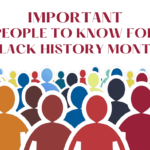Should you teach about W. E. B. Du Bois? While teaching history has many challenges in the current political climate, it is still important that our students get exposed to important historical figures. Black History Month offers a time to focus on influential African Americans. We will explore several important historical figures and why we believe they should be included in the curriculum.

Why should we include W. E. B. Du Bois in our curriculum?
Including a lesson about W. E. B. Du Bois in a curriculum can be beneficial for several reasons:
- Historical Significance:
- W. E. B. Du Bois was a prominent African American intellectual and civil rights activist who played a crucial role in the early 20th-century civil rights movement.
- His work was influential in challenging racial inequality and promoting civil rights, making him a key figure in American history.
- Intellectual Contributions:
- Du Bois was a prolific writer, sociologist, historian, and co-founder of the National Association for the Advancement of Colored People (NAACP).
- Studying his writings and ideas can provide students with insights into critical social issues, particularly regarding race, class, and inequality.
- Du Bois’s Theories and Concepts:
- Du Bois introduced important sociological concepts, such as the “double consciousness” and the “talented tenth,” which are still relevant in discussions about identity, race, and education.
- Diverse Perspectives:
- Including Du Bois in the curriculum ensures that students are exposed to a diverse range of voices and perspectives, contributing to a more comprehensive understanding of American history and society.
- Connection to Current Issues:
- Du Bois’s work is still relevant today, as issues related to racial inequality, social justice, and civil rights continue to be important topics in contemporary society.
- Studying Du Bois can help students make connections between historical events and current social issues.
- Critical Thinking and Analytical Skills:
- Du Bois’s writings provide opportunities for students to develop critical thinking skills by analyzing complex sociological concepts and historical events.
- Cultural Awareness:
- Learning about Du Bois fosters cultural awareness and appreciation for the contributions of African American intellectuals to American society.
- Promoting Inclusivity:
- Incorporating diverse voices in the curriculum promotes inclusivity and helps students see the rich tapestry of American history, including the struggles and achievements of different communities.
- Encouraging Dialogue:
- Studying Du Bois can stimulate classroom discussions about race, inequality, and social justice, fostering an environment where students can engage with and learn from each other.
In summary, including a lesson about W.E.B. Du Bois in the curriculum enriches students’ understanding of American history, promotes diversity, and encourages critical thinking about social issues.
Teaching about W. E. B. Du Bois
As with any historical figure, there are parts of history that are not always suitable for younger students. However, even young students can understand the basic concepts of discrimination and racism and the struggle for equality. While some may say younger children should be shielded from these topics, they can be presented in a way that lets students understand the struggles that different people have faced in the past. I understand that there is quite a bit of debate about how history should be taught, but many districts still include history in their curriculum requirements. I have created resources that present the basic information in a way that is appropriate for younger students.
My biggest issue with teaching history was finding the time to include it in my already busy schedule. One of the best ways I found to teach social studies and science curriculum was by including it in my reading curriculum. When students read a historical biography, they are not only practicing their reading skills, but they are also learning about history. (Plot the biographies on a timeline and you could argue that you are teaching math concepts as well).
Please check out our article about teaching history in the classroom.
My Bilingual Life Teaching Resources
We have a variety of resources available on Teachers Pay Teachers to help you teach about W. E. B. Du Bois.
Check out our Bilingual Bundle here.
That bundle includes both English and Spanish versions of our reading passage and activities in both Google Slides formats and .pdf printable versions. You can find links to purchase individual formats as well.
We have more historical biographies available now and many more are on the way. Here are some of our most popular biographies:
Black History Month Biographies
Women’s History Month Biographies
Hispanic Heritage Month Biographies
If you’d like to try one of our biography activities before you buy, click here to get our FREE Martin Luther King, Jr. Biography Activity Bundle.





